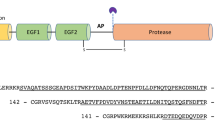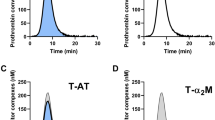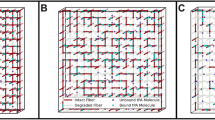Abstract
IN spite of much literature on the clotting of blood, the exact mechanism of the final event, the mode of transformation of soluble fibrinogen to insoluble fibrin by the action of thrombin, remains unknown. The concept of thrombin as a hydrolytic or proteolytic enzyme1,2 has fallen into disfavour3, and in recent years other plausible but unproved mechanisms have been proposed4–6. In a study7 of the proteins of the keratin–myosin–fibrinogen group by end-group assay with fluorodinitrobenzene8, only small amounts of terminal amino-groups could be detected in fibrinogen, although the amounts were not sufficiently small to conclude, as in the case of myosin and tropomyosin, that the molecule is constructed of cyclo-peptide units. The action of purified thrombin, however, results consistently in the appearance of amino-terminal residues of glycine, and whatever the ensuing mechanism, we believe that the fundamental enzymic step in the transformation of fibrinogen to fibrin is associated first with the appearance of these groups. This action of thrombin, which tentatively may be considered as a very specific proteolysis, was discovered independently in Cambridge and in Leeds, and for this reason the relevant observations are reported jointly.
This is a preview of subscription content, access via your institution
Access options
Subscribe to this journal
Receive 51 print issues and online access
$199.00 per year
only $3.90 per issue
Buy this article
- Purchase on Springer Link
- Instant access to full article PDF
Prices may be subject to local taxes which are calculated during checkout
Similar content being viewed by others
References
See Hammarsten, O., “A Textbook of Physiological Chemistry”, 7th English edit., 257 (New York, 1914).
Mellanby, J., J. Physiol., 38, 28 (1908).
Astrup, T., “Adv. Enzymology”, 10, 1 (1950).
Wöhlisch, E., Ergeb. Physiol., 43, 174 (1940).
Mommaerts, W. F. H. M., J. Gen. Physiol., 29, 103, 113 (1946).
Lyons, R. N., Aust. J. Exp. Biol. Med. Sci., 23, 131 (1945).
Bailey, K., Biochem. J. (in the press).
Sanger, F., Biochem. J., 39, 507 (1945).
Jaques, L. B., Biochem. J., 37, 344 (1943).
Porter, R. R., Biochim. Biophys. Acta, 2, 105 (1948).
Lorand, L., Nature, 166, 694 (1950).
Author information
Authors and Affiliations
Rights and permissions
About this article
Cite this article
BAILEY, K., BETTELHEIM, F., LORAND, L. et al. Action of Thrombin in the Clotting of Fibrinogen. Nature 167, 233–234 (1951). https://doi.org/10.1038/167233a0
Issue Date:
DOI: https://doi.org/10.1038/167233a0
This article is cited by
-
A polylactide/fibrin gel composite scaffold for cartilage tissue engineering: fabrication and an in vitro evaluation
Journal of Materials Science: Materials in Medicine (2009)
-
Clinical significance of fibrinopeptide A in acute lymphocytic and non-lymphocytic leukaemia
Blut (1989)
-
Structural aspects of the milk clotting process. Comparative features with the blood clotting process
Molecular and Cellular Biochemistry (1975)
-
Der Mechanismus der Blutkörperchensenkung. XVI. Mitteilung: Hemmung der Senkungswirkung von Fibrinogen durch Fibrinogenuntereinheiten
Blut Zeitschrift für die Gesamte Blutforschung (1971)
-
N-Terminal Disulphide Knot of Human Fibrinogen
Nature (1968)
Comments
By submitting a comment you agree to abide by our Terms and Community Guidelines. If you find something abusive or that does not comply with our terms or guidelines please flag it as inappropriate.



